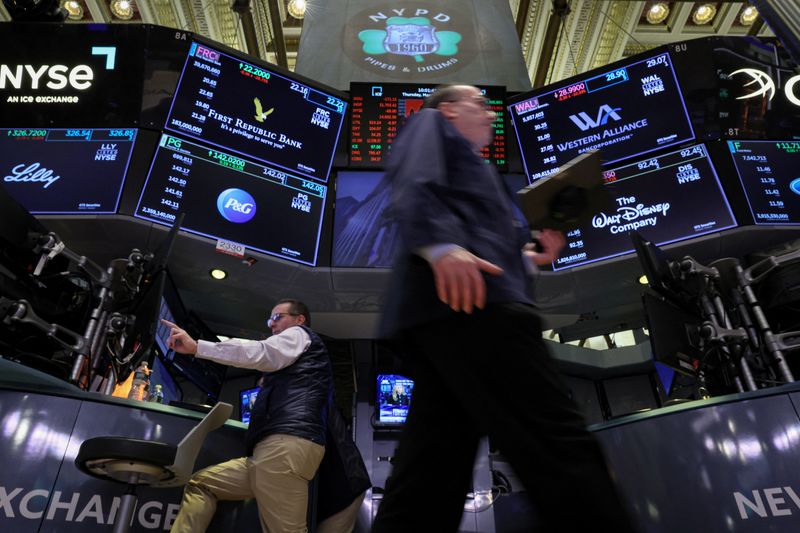Investing.com – February data including consumer prices and retail sales will offer more cues on the prospects for potential Federal Reserve rate cuts. Bitcoin hits record highs, while Wall Street could be in for another volatile week. Here’s what you need to know to start your week.
- US inflation data
Investors will be looking to Tuesday's U.S. inflation data as they try to gauge how soon the Fed could start cutting interest rates.
Economists are expecting February's consumer price index to rise 0.4% after a faster than expected increase of 0.3% in January.
On Thursday, Fed Chair Jerome Powell said it would likely be appropriate to cut rates “at some point this year,” but made it clear that he and his colleagues aren’t ready yet.
Market watchers will also be looking to Thursday’s retail sales data for February, which is expected to rebound 0.8% after falling the same amount a month earlier.
The economic calendar also features updates on industrial production, consumer sentiment and weekly data on initial jobless claims.
Fed officials will be entering the traditional blackout period ahead of their upcoming meeting next week.
- Bitcoin boom
Bitcoin has hit a new all-time high above $70,000, boosted by investor demand for new U.S. spot bitcoin ETFs that launched this year and expectations for global interest rates to fall.
Billions of dollars have flowed into ETFs in the past few weeks, while the market has also been underpinned ahead of an expected upgrade to the ethereum blockchain platform, home to the second-largest digital ether, and a bitcoin "halving" event, which slows the flow of bitcoin minting, in April.
The previous bitcoin boom in 2021 was followed by a "crypto winter", when bankruptcies and collapses at the biggest crypto firms left millions of investors out of pocket, prompting regulators to step up warnings about the risks.
But this does not seem to have deterred a new wave of money from coming in. Crypto fans say the industry has matured, but central bankers and regulators are still wary. Now investors are wondering: how much bigger can it get and is it different this time?
- Oil prices
Oil prices closed 1% lower on Friday and fell even more for the week as markets remained wary of soft Chinese demand even as producer group OPEC+ extended supply cuts.
Both benchmarks fell in the week, with Brent down 1.8% and Crude Oil WTI Futures losing 2.5%.
China last week set an economic growth target for 2024 of around 5%, which many analysts say is ambitious without much more stimulus.
On the supply side, OPEC+ members led by Saudi Arabia and Russia agreed last Sunday to extend voluntary oil output cuts of 2.2 million barrels per day into the second quarter, giving extra support to the market amid concerns over global growth and rising output outside the group.
Energy traders have also been focused on the timing of possible rate cuts by the Fed and the ECB. Lower interest rates could increase oil demand by boosting economic growth.
- Stock market
Wall Street's three main indexes ended lower on Friday, closing out a turbulent week with artificial intelligence darling Nvidia (NASDAQ:NVDA) going into reverse after a recent rally.
For the week the S&P 500 lost 0.26% while Nasdaq fell 1.17% and the Dow Jones Industrial Average dropped 0.93%.
Nvidia ended Friday down more than 5% in its worst one-day performance since late May. Shares in the company still ended the week with gains of over 6% amid a rally that has added more than $1 trillion to its market cap so far this year.
Analysts say investors are locking in profits after the recent run higher in markets.
Given that the upcoming inflation data likely won’t be enough to reassure the Fed that price pressures are cooling quickly enough to warrant a near-term move market participants are likely to remain somewhat cautious.
- UK jobs data
The UK is to release its latest jobs report on Tuesday, with investors and the Bank of England alike focusing on wage growth amid speculation over the timing of a first rate cut.
Average hourly pay decelerated to a rate of 6.2% in December, the slowest pace of growth in over a year, but not slow enough to convince BoE officials that interest rates - at 16-year highs - will need to come down sooner rather than later.
Meanwhile, the Eurozone is to release industrial production data for January. December’s report showed a large increase in production which erased a full year of declines. Another strong reading would be an encouraging sign for first quarter GDP growth.
--Reuters contributed to this report
